
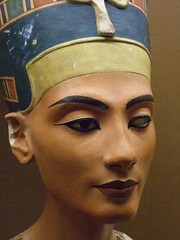 Reproduction of the famous bust of Nefertiti by the sculptor Thutmose at the Rosicrucian Egyptian Museum. Photo by mharrsch via Flickr
Reproduction of the famous bust of Nefertiti by the sculptor Thutmose at the Rosicrucian Egyptian Museum. Photo by mharrsch via FlickrI was familiar with most of the main characters - Nefertiti, Akhenaten (Amenhotep IV), Queen Tiye, the Vizier Ay, Tutankhamun and the general Horemheb. But I did not realize that Nefertiti was probably a daughter of Vizier Ay and had a younger sister (although not all scholars agree) named Mutnodjmet (sometimes spelled Mutbenret). I also knew nothing about the noble general Nakhtmin.
My overall knowledge of the period was based on an excellent lecture series I obtained from The Teaching Company presented by Dr. Bob Brier, as well as information I had picked up reading about Howard Carter's discovery of Tutankhamen's tomb. I had also watched History Channel programs about "The Heretic Pharaoh" and speculations about who might have murdered Tutankhamen (Of course, we now know according to Dr. Zahi Hawass that nobody did - he apparently died of natural causes as a CT scan of his mummy revealed a severely fractured left thigh bone and researchers found DNA from the parasite that causes malaria . For a more thorough discussion of these latest tests, check out my post on the official medical findings in my related blog "History's Medical Mysteries".
 |
| A reproduction of the golden throne of Tutankhamun the young pharaoh and his queen Ankhesenamun. Photo by Mary Harrsch. |
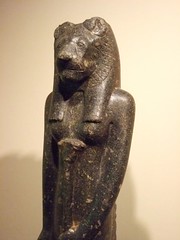 Mutnodjmet was named for the goddess Mut sometimes depicted in her warrior aspect as the feline goddess Sekhmet. Image by mharrsch via Flickr
Mutnodjmet was named for the goddess Mut sometimes depicted in her warrior aspect as the feline goddess Sekhmet. Image by mharrsch via FlickrAs the novel opens, we meet Nefertiti and her half-sister Mutnodjmet at the estate of their father, the vizier Ay, in Akhmim, a provinicial capital in upper Egypt. Nefertiti is described as stunningly beautiful while her darker-skinned half-sister is portrayed as more "average" in appearance but with captivating green eyes that resemble those of a cat. We quickly see that Nefertiti has learned to wield her beauty like a powerful weapon to bend others to her will and is confident she will be soon chosen for the next pharaoh's chief wife by his mother and her aunt, Queen Tiye. Mutnodjment, on the other hand, has learned about herbs and the healing arts and has resigned herself to lifelong service to Nefertiti as the sister to the king's chief wife.
Crown prince Thutmose, son of the ruling pharaoh Amenhotep III unexpectedly dies (court rumors abound that his younger brother had a hand in his death) and Nefertiti now learns she will be married to his younger brother, Amenhotep IV. But, unlike his older brother, Amenhotep IV is not a warrior and has not been groomed for the role he must now play, although he covets it and appears to relish the prospect of ruling the most powerful kingdom in the Near East at the time. In fact, we find that Queen Tiye has chosen Nefertiti because she feels Nefertiti appears to be cunning and ruthless enough to distract the younger prince from a fixation with the religion of Aten and his apparent plans to promote the sun god above the current chief deity Amun, whose priests have once more grown too politically powerful
Before I researched this religious/political controversy, I was under the misconception that Aten was a relatively minor diety that Amenhotep IV adopted as his own because he felt estranged from society, possibly as the result of physical infirmities. I probably developed this misconception after watching too many programs speculating about Amenhotep IV's physical abnormalities as evidenced by his strange representation in art discovered in the excavations at El-Amarna. I was apparently wrong on both counts.
The rivalry between followers of Amun and Re/Aten had been brewing since the Hyksos were expelled about 1530 BCE. As the Egyptians struggled to reunify their empire, a process that required pharaohs to be engaged directly in military activities, administration was often delegated to powerful civilian authorities. These civilian authorities increasingly became synonymous with the priests of Amun, once devout laymen but now wealthy, worldly and corrupt.
Eventually, the priests lusted for power as well and when Tuthmosis II died leaving an under-age heir directed by his co-regent and aunt Hatshepsut, the Amun priests led by the high priest Hapuseneb, made their move proclaiming the new rulers as divine by oracle of Amun, then engineered the superimposition of Hatshepsut over her ward, probably thinking a woman would be easy to control. Hatshepsut's supposedly divine birth is depicted on the walls of the queen's temple at Deir el-Bahri showing her descended from the god Amun.
After Hatshepsut's death, however, Tuthmosis III reasserted pharaonic power, even though, he, too, led a number of arduous military campaigns to resecure Egyptian interests in Syria and Palestine. Although he continued to patronize Amun, he made it clear where the power lay. He even refused to anoint any of his harem as chief royal wife to avoid any ambitious females trying to wrest power from him again.
His successor, Amenhotep (Amenophis) II, launched a campaign to strip the Amun priests of their power after Year 9 of his reign. His successor, Tuthmosis IV, continued his predecessor's battle to curb the power and influence of the Amun priests. Tuthmosis IV, the son of a northern queen, had traditionally worshiped the sun god Re like most people in the north anyway, with worship centered on the northern city of Heliopolis. Tuthmosis IV is the prince whose dream beneath the mighty Sphinx is retold on the famous Dream Stela.
"Look at me, observe me, my son Tuthmosis. I am your father Harmachis-Kepri-Re-Atum. I shall give to you the kingship upon the land before the living."
So Tuthmosis recognized that he was chosen to succeed his father not by Amun but by Harmachis, "Horus in the horizon". And, the priests of the sun god in Heliopolis became the favored cult. The Amun priests tried to retain their control by consolidating their god to Re, hence references that appear to Amun-Re, but this ploy was not as successful as they would have wished.
Tuthmosis IV begins wearing the distinctive beaded shebyu-collar and a disc on his crown to represent the sun god. He also began to emphasize the solar manifestation of the sun - the Aten - with imagery of the solar disc sprouting arms beginning to appear in iconography of the early reign of Tuthmosis IV's sucessor Amenhotep III, the future Akhenaten's father.
However, Amun-Re remained as the official deity of the people because the composite deity was viewed as representing people from both the north and the south - Upper and Lower Egypt - so, at least, in that, the Amun priests had been successful.
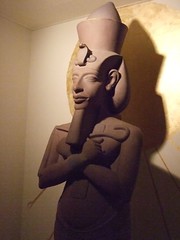 Reproduction of a statue of Akhenaten at the Rosicrucian Egyptian Museum. Image by mharrsch via FlickrMoran does not refer to any infirmities in her descriptions of Amenhotep IV either. There has been much speculation over the years about the young pharaoh's health because of his bizarre depiction in art found at el-Amarna. Theories that he suffered from Froehlich's syndrome, Marfan's syndrome and most recently aromatase excess syndrome or Antley–Bixler syndrome, postulated by pathologists at a clinicopathologic conference at the University of Maryland School of Medicine (see their analysis) have been bandied about. But, Zahi Hawass' team found no evidence of these diseases in Amenhotep IV's mummy during extensive physiological and DNA analyses performed in 2010.
Reproduction of a statue of Akhenaten at the Rosicrucian Egyptian Museum. Image by mharrsch via FlickrMoran does not refer to any infirmities in her descriptions of Amenhotep IV either. There has been much speculation over the years about the young pharaoh's health because of his bizarre depiction in art found at el-Amarna. Theories that he suffered from Froehlich's syndrome, Marfan's syndrome and most recently aromatase excess syndrome or Antley–Bixler syndrome, postulated by pathologists at a clinicopathologic conference at the University of Maryland School of Medicine (see their analysis) have been bandied about. But, Zahi Hawass' team found no evidence of these diseases in Amenhotep IV's mummy during extensive physiological and DNA analyses performed in 2010. But, back to our story. The Vizier Ay moves his family to Malkata Palace, the court of Amenhotep III. You can easily envision its muraled walls and sumptuous gardens from the descriptions Moran provides.
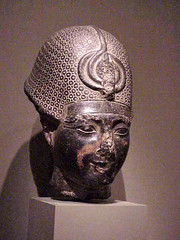 | |
| Head of Amenhoptep III ca. 1380 BCE recarved as Ramses II. Image by Mary Harrsch |
We find his son, Amenhotep IV, appears to despise his father and is anxious to take over the sole rule of Egypt so he can put his plans to become a revered builder and beloved of the people into effect. Like most men in the book, he becomes immediately entranced by Nefertiti even though one of his existing wives, Kiya, is pregnant with Amenhotep IV's child.
 |
| Study of an Egyptian queen consort thought to be Kiya. Image courtesy of Wikipedia. |
Sadly, Moran's Nefertiti is also domineering when it comes to her relationship with Mutnodjmet - so much so that it set my teeth on edge. Nefertiti's ruthless ambition and selfishness even surpass her pharaoh husband. When her sister, Mutnodjmet, falls in love with a young general named Nahktmin, Nefertiti even tries to destroy their relationship because of Nefertiti's obsessive desire to be the sole recipient of her family's love.
Amenhotep IV is crowned as co-regent then announces his plans to build a new capital city in the desert he will call Akhetaten. To fund his new endeavor, he strips temples of Amun of their hoards of gold. He also recalls the army away from the fragile border territories in Syria and Palestine to serve as his labor force in efforts to complete the city more quickly. This enrages his primary general Horemheb, who makes no bones about letting pharaoh know how he feels. Horemheb is promptly banished to Kadesh where, with few troops, he is expected to perish rather quickly in the next Hittite incursion.
Signs of paranoia begin to creep into Amenhotep IV's behavior. Historical evidence that supports Moran's portrayal of Amenhotep IV were actually uncovered at el-Amarna. Ominously, one of only two literary texts recovered from the pharaoh's library there was the "Teaching of Ammenemes I". It warns:
"Beware of subjects who are nobodies, of whose plotting one is not aware. Trust not a brother, know not a friend, make no intimates - it is worthless! When you lie down, guard your heart yourself, for no man has adherents on the day of woe. I gave to the beggar. I raised the orphan, I gave success to the poor as to the wealthy; but he who ate my food raised opposition, and he whom I gave my trust used it to plot..."
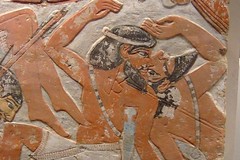 Reliefs depicting battle scenes 18th dynasty Egypt. Image by mharrsch via Flickr
Reliefs depicting battle scenes 18th dynasty Egypt. Image by mharrsch via FlickrStill, Amenhotep IV continues to build his city filled with temples to his new primary god, Aten. As the city rises, Akhenaten, though elated by his shining new city, descends into despair because he senses that the people do not really love him, despite all of the gold he lavishes upon them. He doesn't even trust the army, resorting to employment of Nubians and Asians for his personal guard. His frenetic building activities consumes his attention and he repeatedly ignores serious Hittite incursions in his vassal states in Palestine and Syria.
Scholars seem to be split on this interpretation of events. Some seem convinced that records indicating serious upheavals reflect an inattentive administration while others point to Amarna letters in which provincial rulers earnestly point out that they have followed the instructions of pharaoh. Moran addresses this inconsistency by having Nefertiti's father, the vizier Ay, take over administrative control during this time.
Ay tries desperately to hold things together but Pharaoh orders outrageous responses to pleas of help from his provincial administrators. (Spoiler Alert) When one beseiged city pleads for help, Pharaoh dispatches monkeys dressed as Egyptian soldiers in reply. This incident is so explicit that I would not be surprised if it is based on historical records although I could not find such a reference. I did find a reference to a derogatory bit of imagery from the Amarna period where Pharaoh himself is portrayed as a monkey driving a chariot, though, a clear indication that he was not as beloved of the people as he would have had his courtiers believe.
 Stela depicting the Pharaoh Akhenaten, Nefertiti and three of their six daughters. Image via WikipediaIn the meantime, Nefertiti, feeling pressured by the fact that Kiya has given Pharaoh a son, churns out daughter after daughter in her quest to give Egypt an heir, her desperation increasing with each birth. It was at this point that I actually felt at least a little compassion for her. Struggling to maintain a grip on the reins of power, she promotes herself as the god Aten's favored ruler, having more images of herself carved on public buildings and monuments than the pharaoh himself. This aspect of the story, too, has been born out by excavations at el-Amarna.
Stela depicting the Pharaoh Akhenaten, Nefertiti and three of their six daughters. Image via WikipediaIn the meantime, Nefertiti, feeling pressured by the fact that Kiya has given Pharaoh a son, churns out daughter after daughter in her quest to give Egypt an heir, her desperation increasing with each birth. It was at this point that I actually felt at least a little compassion for her. Struggling to maintain a grip on the reins of power, she promotes herself as the god Aten's favored ruler, having more images of herself carved on public buildings and monuments than the pharaoh himself. This aspect of the story, too, has been born out by excavations at el-Amarna.When archaeologists first pieced together the religious revolution of Amenhotep IV, many Christians became enamored of this early monotheist. Many pointed to the abundence of loving scenes of the pharaoh and his daughters that have been found at Amarna as proof of the benign nature of the young ruler. But, continuing scholarship has revealed that this pharaoh was far from benevolent. Between years 8 and 12 of his reign, Amenhotep IV now renamed Akhenaten, initiated a reign of terror that encompassed not only the priests and followers of Amun but the common peasants as well.
"An order went out from the palace to smash up the divine statues and hack out the names and images of these gods whereever they occurred - on temple walls, on obelisks, on shrines, on the accessible portions of tombs. This was accompanied by a focused attack on the divine birth scenes both of Hatshepsut at Deir el-Bahri and, to a lesser though still discernible extent, on the similar reliefs of his father Amenophis III..." - Nicholas Reeves, Akhenaten: Egypt's False Prophet
Reeves goes on to point out that this was no academic exercise but a real persecution that invoked fear among all the Egyptian people.
"...it was not only from Egypt's large, public monuments that the offending hieroglyphs were excised. As the archaeological record shows, small personal items such as pots for eye make-up and commemorative scarabs were dealt ith in the same relentless fashion. Fearful of being found in possession of such seditious items, the owners themselves gouged or ground out the three offending signs which articulated the god Amun's name, even in tiny cartouches containing the old king's birth name." - Nicholas Reeves, Akhenaten: Egypt's False Prophet
Reeves points to this self-sensorship as evidence that the country was gripped by paranoia fueled by the presence of the King's foreign soldiers (mostly Nubian and Asiatic) who patrolled the streets. Malicious informers also plagued the people. Reeves speculates that a picture painted by Manethos supposedly of Hyksos excesses, may have actually recalled a garbled memory of Akhenaten's Terror:
"...not only did they [pharaoh's men] set towns and villages on fire, pillaging the temples and mutilating images of the gods without restraint, but they also made a practice of using the sanctuaries as kitchens to roast the sacred animals which the people worshipped, and they would compel the priests and prophets to sacrifice and butcher the beasts, afterwards casting the men forth naked." - Nicholas Reeves, Akhenaten: Egypt's False Prophet
Reeves also observes that although temple and tomb reliefs depict the pharaoh and his family adored by a groveling populace, if you look closely you will see pharaoh's guards wear batons to beat back the crowds.
The situation was highly explosive and just awaiting a spark.
In Moran's novel, when plague strikes first the people of Akhetaten and then the royal palace itself, claiming all but two of the pharaoh's own children, people turn back to their old gods in desperate attempts to stop the ravenous harvest of Anubis. Researchers have not yet been able to determine exactly what happened in the chaos of this period. Although a plague is documented in the Near East during this time, there is no direct reference to it in the Amarna letters. But, it would have caused the type of crisis Moran describes in the closing chapters of her novel and definitely would have brought down a pharaoh who promoted himself as his new god's representative on earth. Perhaps, now that Hawass and his team have the latest technology, more definitive autopsies can be performed on more mummies from both the tombs at Amarna as well as Thebes and evidence of plague may surface.
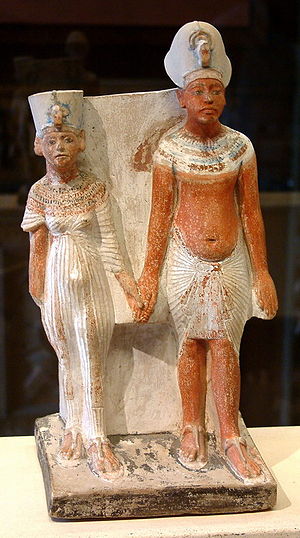 Nefertiti and Akhenaten statuette at the Louvre. Image via Wikipedia
Nefertiti and Akhenaten statuette at the Louvre. Image via WikipediaAs the dream of Amarna collapses, Moran chooses to portray Nefertiti as a co-regent with her husband, who takes sole control after Akhenaten's death and is renamed Ankhkheprure Neferneferuaten then Ankhkheperure Smenkhkare/Neferneferuaten. Although there are scholars who support the theory that Smenkhkare was a younger brother of Akhenaten or even an older brother or half/brother of Tutankhamun, I think Moran's choice of theories is the more probable. Not only did Nefertiti add the name Neferneferuaten to her name while still queen, but her elevation to kingly status was attested to on the Coregency Stela as well as several other unfinished stelae.
"The latter include the Pase stela (depicting two figures wearing crowns who are nevertheless identified as a king and queen by the three uniscribed cartouches); the Berlin 25574 stela (depicting Akhenaten and Nefertiti but with an extra, fourth, cartouche added to indicate two kings rather than a king and queen); and in Meryre II's tomb, a scene in which the figures of Akhenaten and Nefertiti are nearly superimposed over each other (which is interpreted as indicating the oneness of their co-rule)." - Smenkhkare,Wikipedia
(Spoiler alert) New research indicates that Nefertiti's ultimate demise, however, may have been at the hands of her own bodyguard or other members of the army rather than disaffected Aten priests. When I watched the History Channel program about who might have murdered King Tutankhamun, the detectives brought up the discovery of correspondence between an Egyptian queen and the Hittite king,Suppiluliuma, in which the queen of Egypt asked the king to send one of his sons to her to be her husband, pleading that her husband had died and she did not want to be forced to marry a servant. Of course the detectives in the program assumed the queen in question was Ankhesenamun, Tut's widow, not Nefertiti, Akhenaten's widow, to support their conclusion that the "evil" vizier Ay was trying to force the young innocent Ankhesenamum to marry him.
 |
| Suppiluliuma II, last king of the Hittite Empire. Image courtesy of Wikipedia. |
Although the rather convoluted Hittite rendering of the pharaoh's name referred to in the letter could have been alternative names for either Tutankhamun or Akhenaten, researcher John R. Harris argues that the letter was written in the autumn, the same time of year as Akhenaten's death, as evidenced by wine jar dockets towards the end of his 17th regnal year, while the remains of offering plants in Tutankhamun's tomb indicate the young king was buried between the end of February and the middle of March. This meant that Tutankhamun had died 70 days previously, the time required for mummification, and almost 10 months before the season of the communication to Suppiluliuma I. If the Egyptian queen who authored the message was Ankhesenamun, she would have been sereptitiouly negotiating with the Hittites after her grandfather Ay had already assumed the throne. Harris thinks Suppiluliuma would have never agreed to dispatch a son under those circumstances. He also points out that the Egyptian queen's name in the letter was not a name at all but the Hittite rendering of the Egyptian title for king's wife "par excellence" and only Nefertiti, not young inexperienced Ankhesenamun, would have been referred to in that way. Lastly, Harris points to references in the Hittite annals to military action in progress against Amqi, also referred to in vassal correspondence in the Amarna letters. By the time Tutankhamun died, Akhetaten (el-Amarna) had already been abandoned as Egypt's administrative center.
I don't think Nefertiti would have offered herself in a marriage pact with the Hittites unless she needed someone with military might at least equivalent or superior to her own Egyptian army, to help her subvert a coup d'etat by her own army commanders and retain her grip on power. The army general(s), particularly Horemheb, would have reacted swiftly and decisively upon learning of such an offer as he/they apparently did, murdering the Hittite prince not far from Egypt's border. You might wonder why Horemheb would have delayed seizing the throne, though, until after the death of Tutankhamun. He may have viewed the young Tutankhamun as an easily manipulated puppet, much like the Roman senate led by the optimates, viewed the young Octavian. The vizier Ay, Ankhesenamun's grandfather, possibly Queen Tiye's brother, and an astute politician who had been intimately involved in state administration since the rule of Amenhotep III, was probably not easy to get around either. Otherwise, Horemheb, a mere commoner, would not have had to eventually force the lady Mutnodjmet, Nefertiti's half-sister, to marry him to legitimize his rule.
 |
| Sculpted portrait of the handsome General Nakhtmin. Image courtesy of Wikipedia. |
(Spoiler alert) Moran included one more little poignant touch to the conclusion of her novel that also had a basis in archaeological evidence. Little Tutankhamun, whose mother Kiya died during his birth, is adopted by the lady Mutnodjmet and General Nakhtmin. In my research I noticed that two shabti were found in Tutankhamun's tomb that were the only gifts from a non-royal person and they were dedicated by General Nakhtmin. Egyptian history could have been much different if General Nakhtmin, Pharaoh Ay's designated successor, had successfully triumphed over Horemheb although Egypt may not have experienced the long rule of Ramses II if that had happened. Horemheb died without issue so one of his own commanders, Ramesses, ascended the throne, founding the 19th dynasty and giving Moran a sequel to write, "The Heretic Queen", about the lady Mutnodjmet's daughter Nefertari and the pharaoh Ramesses II.
Michelle Moran truly brought the Amarna period to life for me, so much so that I eagerly poured over research books and articles to learn even more after finishing it. To me, that is always a clear indication of a gifted historical fiction author.
I also enjoyed a tour of virtual Amarna up at Heritage Key:




